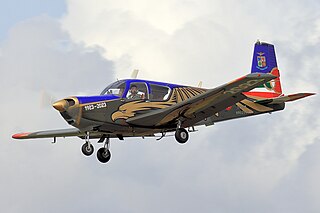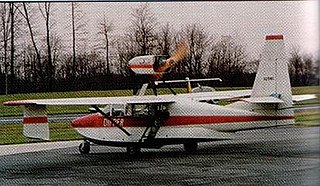
The Piper PA-15 Vagabond and PA-17 Vagabond are both two-seat, high-wing, conventional gear light aircraft that were designed for personal use and for flight training and built by Piper Aircraft starting in 1948.

The Gulfstream American GA-7 Cougar is an American all-metal, 4-seat, twin-engined light aircraft. The Cougar was a twin-engine development of the Gulfstream American AA-5B Tiger and traces its lineage to the AA-1 Yankee Clipper and the Bede BD-1.

The Auster J/1U Workmaster is a late 1950s British single-engined single-seat high-wing agricultural monoplane built by Auster Aircraft Limited at Rearsby, Leicestershire. Of traditional high-wing layout, it carries 90 gallons of spray fluid in a tank beside the pilot, an extra seat being provided for a passenger. The Lycoming 0-360-A engine of 180 h.p. driving a McCauley v.p. propeller giving it ample power; and slotted ailerons and balanced tail controls providing good handling. Oversize tyres were fitted. Take-off run at 2,550 lb gross weight and cruising speed at 65 per cent power are respectively 180 yd and 88 miles per hour (142 km/h). Britten-Norman spray gear was provided by Crop Culture, and this company ordered nine Workmasters.

The Partenavia P.64B/P.66B Oscar is an Italian two/four-seat, single-engined, high-wing monoplane built by Partenavia.
The Aquaflight Aqua I, also known as the W-6 was a 6-seat amphibious aircraft developed in the United States shortly after World War II.

The SIAI-Marchetti S.205 is an Italian four-seat, single-engine, light airplane, manufactured by SIAI-Marchetti. The S.205 made its maiden flight in 1965. The Italian Air Force employs a version called S.208.

The AS/SA 202 Bravo is a two to three-seat civil light aircraft jointly designed and manufactured by the Swiss company Flug- und Fahrzeugwerke Altenrhein (FFA) and the Italian company Savoia-Marchetti. The aircraft was designated the AS 202 in Switzerland, and the SA 202 in Italy.
The Aviation Industries of Iran AVA-202 is an Iranian two-seat, light aircraft designed as a trainer and sporting aircraft. It was intended for the Iranian domestic market to avoid dependence on imports.
The Turbay T-1 Tucán was an Argentine single-engined single-seat light touring monoplane designed by Alfredo Turbay and built by Sociedad Anonima Sfreddo & Paolini. It first flew in April 1943.
The I.S.T. L-17 Masang was a two-seat, single engine, low wing monoplane aircraft designed and built in the Philippine Republic in the mid-1950s. It was intended for both touring and training.

The Bushcaddy L-162 Max is a Canadian kit aircraft that was designed by Sean Gilmore and produced by Canadian Light Aircraft Sales and Service and most recently by Bushcaddy. The aircraft is supplied as a kit for amateur construction.
The Toyo Kukku T-T.10 is a low wing, single engine training aircraft which seats two in tandem. It was designed and built in Japan in 1952.

The Kawasaki KAT-1 is a Japanese primary trainer, seating two in tandem, designed to compete for a Japanese Air Defense Force (JADF) contract in the mid-1950s. Only two were completed.

The Team Tango Foxtrot, or Foxtrot 4, is an American amateur-built aircraft, designed and produced by Team Tango of Williston, Florida. The aircraft is supplied as a kit for amateur construction, with or without factory builder assistance.

The Speedtwin E2E Comet 1, originally named the Phillips ST1 Speedtwin, is a two-seat, twin engined aircraft designed in the UK to be capable of aerobatics and the only civil twin certified for intentional spinning. After a long development time, just two have been built.

The Collins Dipper was an American homebuilt flying boat that was designed and produced by Collins Aero of Chadds Ford, Pennsylvania and first flown in 1982. The aircraft was supplied in the form of plans for amateur construction. Only one was built and none remain registered.

The Starfire Firebolt, sometimes called the Starfire Firebolt Convertible, due to its removable canopy, is an American homebuilt aerobatic biplane that was designed by G. H. "Mac" McKenzie and produced by Starfire Aviation of Tempe, Arizona. When it was available the aircraft was supplied in the form of plans for amateur construction, with some pre-fabricated parts available.
The Ibis GS-501 Urraco (Magpie) is a Colombian homebuilt aircraft that was designed and produced by Ibis Aircraft of Cali, introduced in 2000. The aircraft is supplied as a complete ready-to-fly-aircraft or as a kit for amateur construction.
The Ibis GS-750 Grand Magic is a Colombian homebuilt aircraft, designed and produced by Ibis Aircraft of Cali, introduced in 2006. The aircraft is supplied as a complete ready-to-fly-aircraft or as a kit for amateur construction.

The Aero East Europe Sila is a family of Serbian ultralight and light aircraft, designed and produced by Aero East Europe of Kraljevo and later of Jagodina, introduced at the AERO Friedrichshafen show in 2013. The design is supplied complete and ready-to-fly.
















